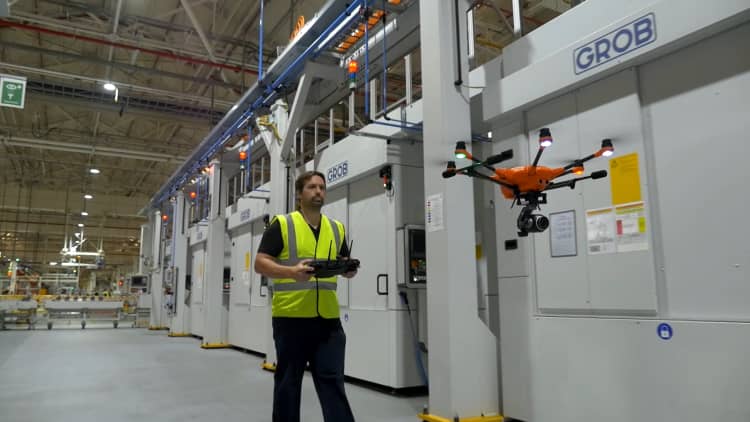
There is a new sight buzzing around a Ford engine factory in London: drones.
The second-largest U.S. automaker is now using drones to perform key inspections in difficult-to-reach places around the Dagenham Engine Plant. The unconventional move saves Ford considerable time and money and brings several other advantages, executives say.
In the past, plant managers used to have to shut down the factory at least once a year to perform risky and time-consuming inspections on high-up structures, parts of the factory's roof and other hard-to-reach places. The drones allow the Michigan-based automaker to conduct safety inspections without shutting down production.
The drones also give Ford a more objective plant maintenance record, preventing arguments over the diagnosis and possible solutions to problems, said Pat Manning, a machine production manager for the EcoBlue diesel engine at the plant, where it's code named Panther.
"The video images are fantastic and are a great tool for us," Manning said.
One of the most common inspections involves overhead structures known as gantries. These are long linear frames suspended near the roof and support a track that shuttles a robotic arm around the plant. The arms on these tracks are what pick up parts in one place and feed them into the machines along the factory floor.
There are around 200 gantries in this plant, and they need to be inspected to ensure they don't break down or break loose and fall onto the floor, equipment or people.
The plant has typically done inspections during a three-week shutdown in the summer. On each of the plant's four machine lines, a team of up to six people would roll in motorized lifts and build scaffolds to reach the gantries.
The factory had been looking for a way to make the process more efficient, and one worker joked they ought to mount a remote control car onto the track with a camera attached that could zip back and forth and take footage.
Then someone suggested a drone.
The factory worked with some local companies to develop a custom drone mounted with several cameras, including a thermal imaging camera that can sense heat, a wide-angle lens and a close-up lens. It can take video or still images.
The drone allows a team of two do what had taken almost two-dozen people to do, and the amount of time it takes to inspect a single 120-foot gantry was reduced from 12 hours to 12 minutes. The plant doesn't need to shut down production either, and it allows for more frequent inspections.
It also eliminates the risk of having to scale 150 feet to inspect the gantries.
The drones can also monitor machines and power cable temperatures as well as inspect robots, overhead conveyor belts, cranes, hoists and the roof for leaks.
The team is also exploring the possibility of using the drones for drain and sewer inspections as well as emergency lighting.
The video and still footage the cameras take have other advantages. They can be stored, allowing the plant to compare images over time and observe changes or patterns.






